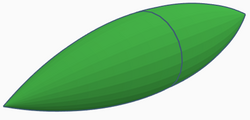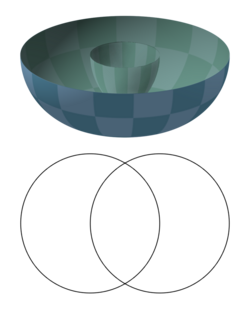Lemon (geometry)
 From HandWiki - Reading time: 3 min
From HandWiki - Reading time: 3 min
In geometry, a lemon is a geometric shape that is constructed as the surface of revolution of a circular arc of angle less than half of a full circle rotated about an axis passing through the endpoints of the lens (or arc). The surface of revolution of the complementary arc of the same circle, through the same axis, is called an apple.
The apple and lemon together make up a spindle torus (or self-crossing torus or self-intersecting torus). The lemon forms the boundary of a convex set, while its surrounding apple is non-convex.[1][2]
The ball in North American football has a shape resembling a geometric lemon. However, although used with a related meaning in geometry, the term "football" is more commonly used to refer to a surface of revolution whose Gaussian curvature is positive and constant, formed from a more complicated curve than a circular arc.[3] Alternatively, a football may refer to a more abstract orbifold, a surface modeled locally on a sphere except at two points.[4]
Area and volume
The lemon is generated by rotating an arc of radius [math]\displaystyle{ R }[/math] and half-angle [math]\displaystyle{ \phi_m }[/math] less than [math]\displaystyle{ \pi/2 }[/math] about its chord. Note that [math]\displaystyle{ \phi }[/math] denotes latitude, as used in geophysics. The surface area is given by[5]
[math]\displaystyle{ A=2\pi R^2\int_{-\phi_m}^{\phi_m}(\cos\phi-\cos\phi_m)d\phi }[/math]
The volume is given by
[math]\displaystyle{ V=\pi R^3\int_{-\phi_m}^{\phi_m}(\cos\phi-\cos\phi_m)^2\cos\phi d\phi }[/math]
These integrals can be evaluated analytically, giving
[math]\displaystyle{ A=4\pi R^2(\sin\phi_m-\phi_m\cos\phi_m) }[/math]
[math]\displaystyle{ V=\tfrac{4}{3}\pi R^3\left[\sin^{3}\phi_m-\tfrac{3}{4}\cos\phi_m(2\phi_m-\sin2\phi_m)\right] }[/math]
The apple is generated by rotating an arc of half-angle [math]\displaystyle{ \phi_m }[/math] greater than [math]\displaystyle{ \pi/2 }[/math] about its chord. The above equations are valid for both the lemon and apple.
See also
- Sears–Haack body
- List of shapes
References
- ↑ Kripac, Jiri (February 1997), "A mechanism for persistently naming topological entities in history-based parametric solid models", Computer-Aided Design 29 (2): 113–122, doi:10.1016/s0010-4485(96)00040-1
- ↑ Krivoshapko, S. N.; Ivanov, V. N. (2015), "Surfaces of Revolution", Encyclopedia of Analytical Surfaces, Springer International Publishing, pp. 99–158, doi:10.1007/978-3-319-11773-7_2
- ↑ Coombes, Kevin R.; Lipsman, Ronald L.; Rosenberg, Jonathan M. (1998), Multivariable Calculus and Mathematica, Springer New York, p. 128, doi:10.1007/978-1-4612-1698-8, ISBN 978-0-387-98360-8
- ↑ Borzellino, Joseph E. (1994), "Pinching theorems for teardrops and footballs of revolution", Bulletin of the Australian Mathematical Society 49 (3): 353–364, doi:10.1017/S0004972700016464
- ↑ Verrall, Steven C.; Atkins, Micah; Kaminsky, Andrew; Friederick, Emily; Otto, Andrew; Verrall, Kelly S.; Lynch, Peter (2023-01-23). "Ground State Quantum Vortex Proton Model" (in en). Foundations of Physics 53 (1): 28. doi:10.1007/s10701-023-00669-y. ISSN 1572-9516. https://doi.org/10.1007/s10701-023-00669-y.
External links
- Weisstein, Eric W.. "Lemon". http://mathworld.wolfram.com/Lemon.html.
- Football shaped (spindle type) surface of positive constant curvature in the University of Groningen model collection
 |
 KSF
KSF


